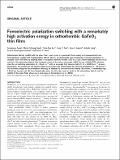Ferroelectric polarization switching with a remarkably high activation energy in orthorhombic GaFeO3 thin films
Abstract
Orthorhombic GaFeO3 (o-GFO) with the polar Pna21 space group is a prominent ferrite owing to its piezoelectricity and ferrimagnetism, coupled with magnetoelectric effects. Herein, we demonstrate large ferroelectric remanent polarization in undoped o-GFO thin films by adopting either a hexagonal strontium titanate (STO) or a cubic yttrium-stabilized zirconia (YSZ) substrate. The polarization-electric-field hysteresis curves of the polar c-axis-grown o-GFO film on a SrRuO3/STO substrate show the net switching polarization of ~35 μC cm−2 with an unusually high coercive field (Ec) of ±1400 kV cm−1 at room temperature. The positive-up and negative-down measurement also demonstrates the switching polarization of ~26 μC cm−2. The activation energy for the polarization switching, as obtained by density-functional theory calculations, is remarkably high, 1.05 eV per formula unit. We have theoretically shown that this high value accounts for the extraordinary high Ec and the stability of the polar Pna21 phase over a wide range of temperatures up to 1368 K.
Citation
Song , S , Jang , H M , Lee , N-S , Son , J Y , Gupta , R , Garg , A , Ratanapreechachai , J & Scott , J F 2016 , ' Ferroelectric polarization switching with a remarkably high activation energy in orthorhombic GaFeO 3 thin films ' , Asia Materials , vol. 8 , e242 , pp. 1-9 . https://doi.org/10.1038/am.2016.3
Publication
Asia Materials
Status
Peer reviewed
ISSN
1884-4057Type
Journal article
Description
This work was supported by the National Research Foundation (NRF) Grants funded by the Korea Government (MSIP) (Grant No. 2012R 1A1A2041628 and 2013R 1A2A2A01068274). The work at Cambridge was supported by the Engineering and Physical Sciences Research Council (EPSRC). AG and RG thank the Department of Science and Technology for the financial support (Grant No. SB/S3/ME/29/2013).Collections
Items in the St Andrews Research Repository are protected by copyright, with all rights reserved, unless otherwise indicated.

